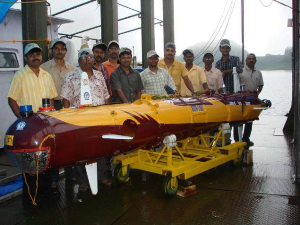Jan 19 2011
The Central Mechanical Engineering Research Institute (CMERI), a part of the Council of Scientific and Industrial Research (CSIR) based in India, has created the Autonomous Underwater Vehicle (AUV) for performing ocean missions. The prototype of the AUV is cylindrical in shape and is named AUV-150, which is designed to function under the ocean up to 150 m depth.
The ocean trails of the AUV were started off in the first week of January 2011 at the Chennai port. The prototype was created by a research team of the Robotics and Automation division of CSIR-CMERI in technological partnership with the Indian Institute of Technology (IIT), Kharagpur, who developed the lab-scale model of the prototype. The Ministry of Earth Sciences is funding the project.
 The Autonomous Underwater Vehicle
The Autonomous Underwater Vehicle
The AUV-150 can perform underwater missions such as surveillance actions, oceanographic studies and ocean floor mapping using data collected by its in-built sensors.
The AUV-150’s hybrid communication channels enable it to use acoustic communication while under water and automatically change to radio frequency when on surface. Gautam Biswas, CMERI Director said that the AUV has autonomous navigation, power, propulsion and control systems. It uses navigational sensors such as the inertial navigation system, altimeter and depth sonar to identify its geographical position when moving under water and forward-looking sonar features to ensure safe passage and avoid obstacles, he added. He further said that the AUV has a weight of 490 kg and could attain a speed of up to four knots. It also features extra roll stability and payload sensors such as side scan sonar, camera and similar devices.
The AUV went through a number of still water trials at the Underwater Acoustic Research Facility (UARF) of the Defense Research and Development Organization over the past two years. The facility is located at the Idukki Reservoir of Kerala State. The final state of the sheltered water trials was carried out in the reservoir from September to October 2010. The vehicle’s image processing potential will be evaluated during the Ocean trials.